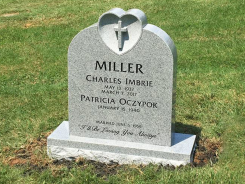A gravestone, monument, or tombstone is a stele or marker. Usually, the stone is put over a grave. They are conventional for internments in the Christian, Jewish, and Muslim religions, among others. By and large, they have the expired’s name, date of birth, and date of death engraved on them, alongside an individual message or petition. Yet, they may contain bits of funerary craftsmanship, particularly subtleties in stone alleviation. In numerous pieces of Europe insetting, a photo of the expired in a casing is normal. Initially, a Headstones was the stone top of a stone casket, or the final resting place itself, and a tombstone was the stone section laid over a grave.
Use
The stele (plural stelae), as it is brought in an archeological setting, is probably the most conventional type of funerary craftsmanship. Presently, every one of the three terms is likewise utilized for markers set at the grave’s top. A few graves in the eighteenth century also contained footstones to differentiate the foot end of the grave. This occasionally formed into full curb sets that denoted the entire edge of the grave. Footstones were seldom commented on with more than the expired’s initials and year of death, and some of the time, a dedication artisan and plot reference number. Numerous graveyards and churchyards have eliminated those additional stones to ease grass cutting by machine trimmer. Note that in some UK graveyards, the head, and undoubtedly just, marker is set at the foot of the grave.

Attributable to soil development and downhill wet blanket on mild inclines, more seasoned gravestones and footstones can frequently be discovered inclined at a point. After some time, this development can bring about the stones being sited a few meters from their unique area.
Graves and any related dedications are a concentration for grieving and recognition. The names of family members are frequently added to a headstone throughout the long term, with the goal that one marker may account for the death of a whole family spread over decades. Since headstones and a plot in a burial ground or churchyard cost cash, they are additionally an image of riches or unmistakable quality in a network. A few tombstones were even appointed and raised to their memory by individuals who were living, as a demonstration of their riches and status. In a Christian setting, the well off regularly grew expound commemorations inside houses of worship instead of basically outside headstones. Crematoria often offer comparable options in contrast to families who don’t have a grave to stamp, however, who need a concentration for their grieving and recognition. Cut or cast dedicatory plaques inside the crematorium, for instance, may fill this need.
Materials
A graveyard may follow public codes of training or autonomously recommend the size and utilization of specific materials, particularly in a preservation zone. Some may restrict the putting of a wooden dedication to a half year after burial, after which a more lasting remembrance must be put. Others may require stones of a specific shape or position to encourage grass-cutting. Gravestones of rock, marble, and different sorts of stone are typically made, introduced, and fixed by fantastic bricklayers. Graveyards require customary investigation and upkeep, as stones may settle, overturn, and, on uncommon events, fall and harm people, or graves may essentially get congested, and their markers lost or vandalized.
Reclamation is a particular activity for a fantastic artisan. Indeed, even abundance expulsion expects care to abstain from harming the cutting. For instance, ivy should just be cut at the base roots and left to cease to exist usually, never pulled off powerfully. Numerous materials have been utilized as markers.
